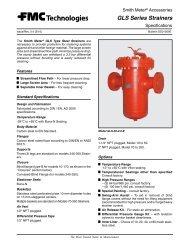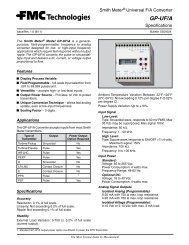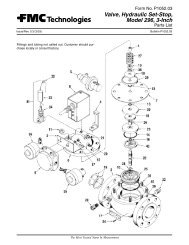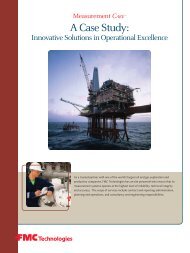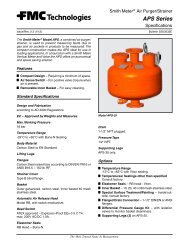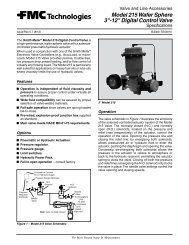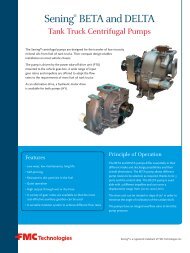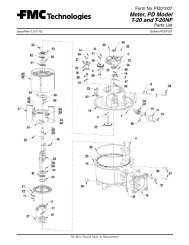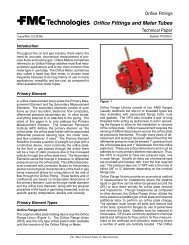Proline Promass 83E/F/O Operation Manual - FMC Technologies
Proline Promass 83E/F/O Operation Manual - FMC Technologies
Proline Promass 83E/F/O Operation Manual - FMC Technologies
You also want an ePaper? Increase the reach of your titles
YUMPU automatically turns print PDFs into web optimized ePapers that Google loves.
Commissioning <strong>Proline</strong> <strong>Promass</strong> 83Triggering warning messagesIf required, a limit value can be assigned to all the process/device parameters relevant to thediagnostic functions. A warning message is triggered if this limit value is exceeded functionWARNING MODE (7403).The limit value is entered into the measuring system as an absolute (+/-) or relative deviation fromthe reference value function WARNING LEVEL (74…).Deviations arising and recorded by the measuring system can also be output via the current or relayoutputs.Data interpretationThe way the data recorded by the measuring system is interpreted depends largely on theapplication in question. This means that users must have a very good knowledge of their specificprocess conditions and the related deviation tolerances in the process, which have to be determinedby the users themselves in each individual case.For example, when using the limit function it is especially important to know the minimum andmaximum deviation tolerances allowed. Otherwise there is the danger that a warning message istriggered inadvertently during "normal" process fluctuations.There can be various reasons for deviating from the reference status. The following table providesexamples and pointers for each of the six diagnosis parameters recorded:Diagnosis parametersMass flowDensityReference densityTemperatureMeasuring tube dampingSensor symmetryOperating frequencyfluctuationTube damping fluctuationPossible reasons for deviationA deviation from the reference status indicates possible zero point shift.A deviation from the reference status can be caused by a change in the measuring tuberesonance frequency, e.g. from deposits in the measuring tube, corrosion or abrasion.The reference density values can be interpreted in the same way as the density values. Ifthe fluid temperature cannot be kept completely constant, you can analyze the referencedensity (density at a constant temperature, e.g. at 20 °C) instead of the density.Ensure that the parameters required for calculating the reference density have beencorrectly configured (functions REFERENCE TEMPERATURE and EXPANSION COEFF.).Use this diagnosis parameter to check the functionality of the PT 100 temperature sensor.A deviation from the reference status can be caused by a change in measuring tubedamping, e.g. from mechanical changes (coating buildup, corrosion, abrasion).Use this diagnosis parameter to determine whether the sensor signals are symmetrical.A deviation in the operating frequency fluctuation indicates possible gas content in themedium.A deviation in the tube damping fluctuation indicates possible gas content in the medium.Page 76 • MN0M022Issue/Rev. 0.2 (12/12)



